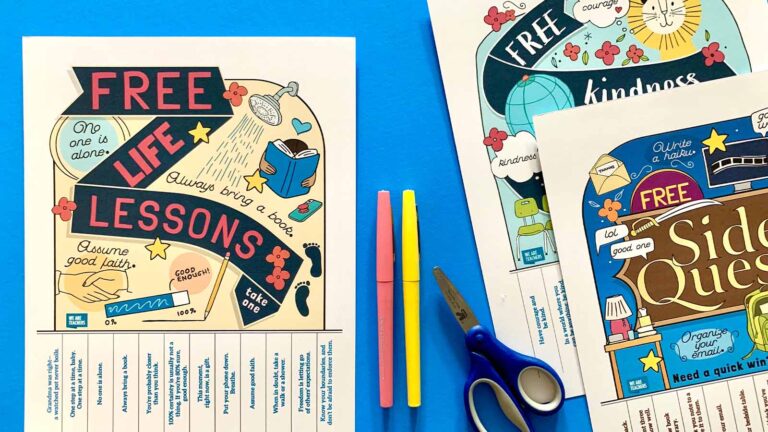We have a problem with bullying in our schools. And it’s not the one you think. Indeed, while there is news story after news story about student-on-student bullying, no one is talking about the problem of teacher-on-teacher bullying. But for teachers facing harassment from their colleagues every day, the proverbial struggle is real.
These teachers lived it.
Megan M. was a brand new teacher when she was assigned to co-teach with a senior teacher. “We did not get along well,” she shares. “She would talk behind my back with other teachers. I could always tell when she was leaving the room to complain about me.”
The senior teacher started treating Megan as if she were her personal teaching assistant, assigning her menial tasks and duties. In addition, she criticized her in front of students. Megan despaired that she would be stuck in this unfair and unequal partnership.
Mark J. was a sixth grade teacher with an impressive resume. When he moved to a new state, he had no problem finding a position. Once there, however, he found his teaching philosophy was not in sync with the assessment-focused, data-driven focus of his new school. “My number one goal,” he says, “is building relationships with students. And yes, it can be time-consuming in the beginning, but in the end I truly believe it leads to greater achievement.”
His colleagues, however, couldn’t understand why Mark spent so much time on “that touchy-feely” stuff. They criticized him at every turn and pressed him to spend more time on the type of drill-and-kill activities he hated. Mark wondered if he had made a big mistake.
Sheila D. was a veteran teacher who found herself on a team with two brand new teachers after her longtime teaching partners retired. Although a gifted educator, Sheila had been doing things the same way for many years and was not a huge fan of technology. Her new colleagues were very tech-savvy and full of new (and in their opinion, better) ideas about the way their curriculum should be taught.
Although their ideas took her out of her comfort zone, she tried to be a collaborative team member but felt challenged at every team meeting by her new teammates (and outnumbered!) Discouraged by all the changes and embarrassed that she couldn’t keep up, she wondered if it was time to retire like her friends.
[contextly_auto_sidebar]
Teacher-on-teacher bullying defined.
It’s important to note that as with students, bullying from colleagues is different from ordinary conflict or occasional meanness. In order for behavior to be bullying, it needs to follow an abusive, repetitive pattern and can include behaviors such as ridicule, exclusion, shaming, and aggression. Bullying from colleagues can be verbal or physical. And it’s happening too often in our schools.
So what can you do if you are a victim of teacher-on-teacher bullying?
Bullying can take a heavy toll on a teacher’s confidence and morale. Being criticized and micromanaged is super stressful. On the other end of the spectrum, being ignored and excluded leads to feelings of painful isolation. It’s easy to understand why many teachers who have been bullied walk away. But it doesn’t have to be that way. The good news is there are a number of different strategies you can use to cope with bullying behavior, depending on your situation and your personality:
Start by knowing it’s not your fault.
A person who bullies is on a power trip. They want others to feel inferior and isolated. Bullying is an intentional attack designed to threaten and intimidate. And no one, not students and not teachers, deserves to be bullied.
Remain calm.
Being treated badly by a coworker is so incongruous with the work we do as teachers—pouring our hearts and souls into nurturing and encouraging our students. It’s easy to take it very personally and react emotionally. Don’t let it consume you. Focus on your students and your work and try to give it as little power as you can.
Don’t engage.
As they say, don’t feed the beast. Try your best not to engage when confronted with bullying behavior—at least not immediately. As tempting as it may be to snap back, maintain your professionalism, and refuse to be triggered. Most of the time, all a bully wants is a reaction. Don’t give them the satisfaction.
Distance yourself.
Whenever possible, limit your interaction with the bully. If you’re on a committee with the person, ask to be reassigned. At lunchtime, when they take center court in the staff lounge, eat elsewhere. Sit with supportive colleagues and teammates at staff meetings. As often as you can, put physical distance between yourself and the bully.
Beef up your communication skills.
Many times bullies are masters at passive-aggressive behavior. Learn communication skills that will help you effectively manage these behaviors. Here is one helpful article to get you started: How to Handle a Passive Aggressive Colleague
Document everything.
This point is critical. Once you detect a pattern in a bully’s behavior, it is essential to document every incident. Take notes on every uncomfortable situation and save every email. Note locations and times. Describe the situation and list any witnesses present. If the time comes to take action against a teacher bully, the more documentation you have the stronger your case will be.
Bring in the union.
If you are a union member, reach out to your rep. Inquire about your district’s workplace harassment and bullying policies. Even if you’re not ready to take action, they may be able to provide you with valuable resources.
Schedule an intervention.
Most of us go out of our way to avoid conflict, but the time may come when a direct confrontation is necessary. The key is to do it in a way that works. If you don’t feel safe enough to speak with the person who has offended you alone, ask a second person (ideally an authority figure) to be present. Describe in detail the offending behavior and ask them to stop immediately. Make it clear that you will make a formal complaint if their behavior does not change. In general, bullies don’t expect confrontation and most will back down at this point.
File a formal complaint.
Finally, if the bullying behavior persists, file a formal complaint with your school district. Hopefully, leaders will take action to resolve the situation, although once it gets to the district level it is out of your hands. Filling a formal complaint will at least give you peace of mind that you stood up for yourself and did everything in your power to stop the bullying behavior.
Through it all …
… make it a priority to stay healthy. Put extra effort into practicing self-care. Surround yourself with supportive friends and family. When you’re away from work don’t perseverate on the situation. Fill yourself up with real life. At school, focus on your students and the very important work you’re doing.
Being the victim of a teacher bully is a horrible experience, but it is survivable. You may not come out of it unscathed, but by taking the course of action that works best for you, you’ll undoubtedly come out stronger and wiser.
Have you been the victim of teacher-on-teacher bullying? Come share your experiences in our WeAreTeachers HELPLINE group on Facebook.
Plus, 8 Ways to Create Student Upstanders in a Bullying Culture.


